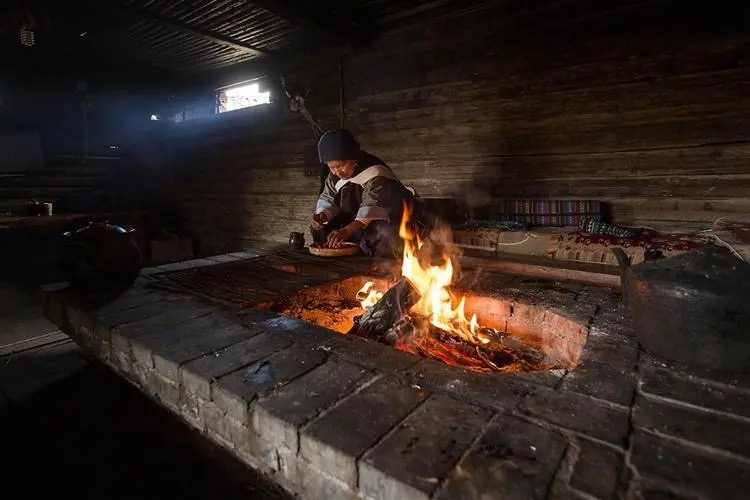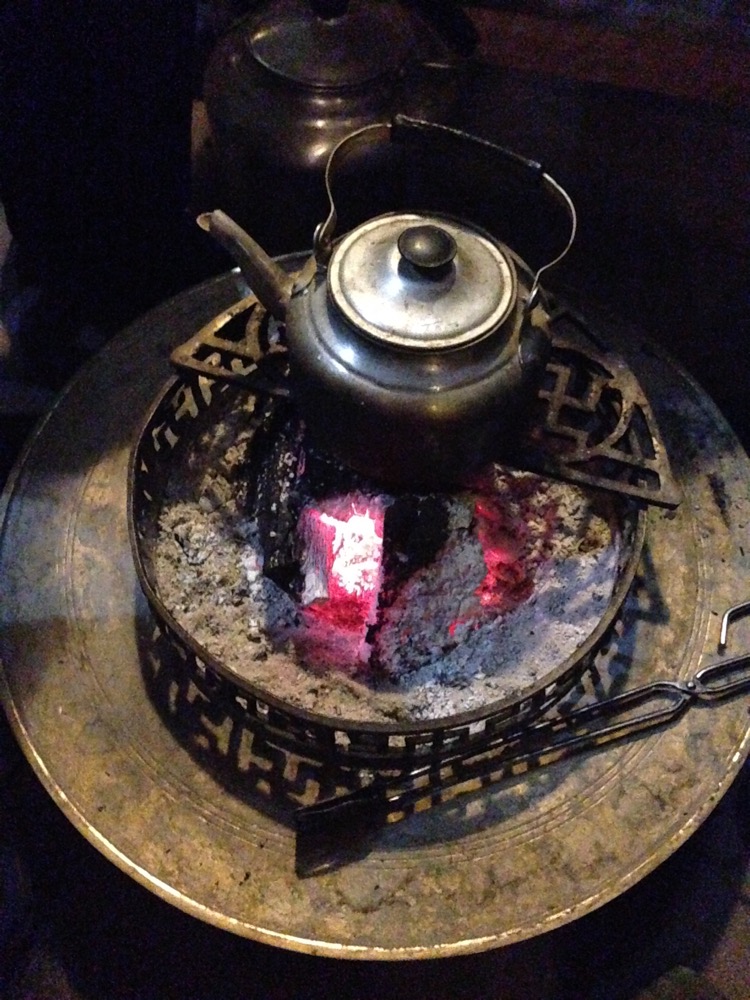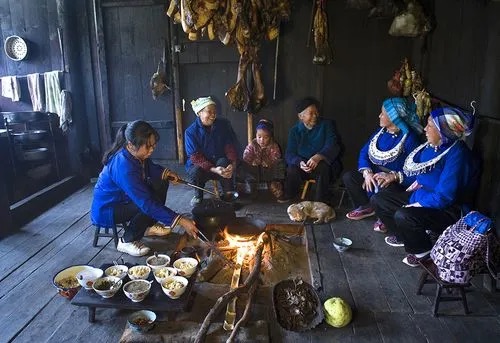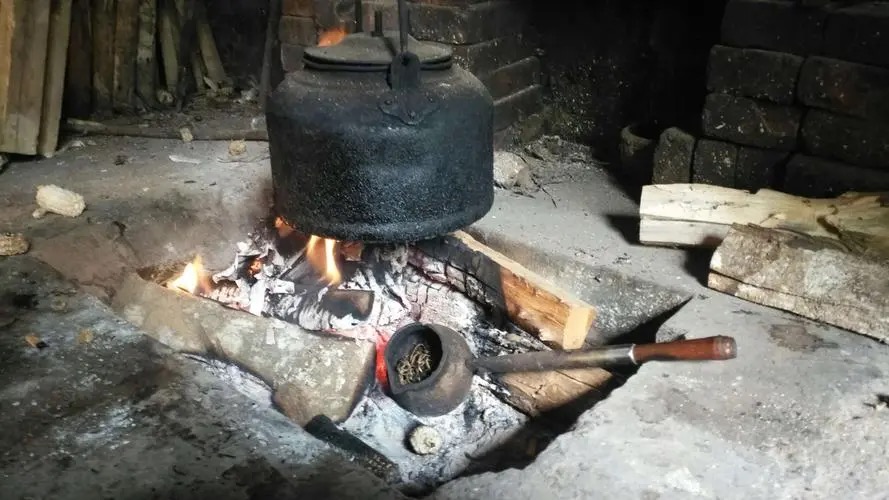“Huotang,” also known as “fire pit” or “fire hearth,” is a 1-meter-square earthen area inside a house. In the past, three stones were set up in the fire pit for the purpose of cooking and boiling. Later on, iron tripods were used instead. The main fire pit is filled with smoke and fire throughout the year, used for cooking during the day and heating in the evening. Wood is commonly used as fuel. In many ethnic groups such as the Dai and Dong, the fire pit is a crucial part of life, and an annual fire pit ritual is conducted to pray for the well-being of the family.
The fire pit is an essential component of Chinese rural culture, representing a unique symbol in traditional Chinese culture. It serves not only as the center of a household and community but also as an important space for daily life and social interactions.

The fire pit typically consists of a fixed earthen or stone pit where wood or coal is burned. A layer of stones or bricks covers the pit for cooking and heating purposes. Around the fire pit, people can place cooking utensils, food, and drinks, enjoying both warmth and delicious meals. In the cold winter, the fire pit becomes a warm gathering place for family members and a welcoming space for hosting guests.
Fire Pond and Ethnic Customs
Fire Pit Symbolism:
In some ethnic groups, the fire pit is considered a symbol of family and kinship. Establishing a new fire pit during the construction of a new house or when a small family separates from the parents’ home is seen as a symbolic act, representing the differentiation and formation of a new family lineage. The fire pit is revered as it is believed to influence people’s livelihoods and reproduction, symbolizing these aspects in the minds of the community.
Fire Pit Rituals and Sacrifices:

Among certain ethnic minorities, the fire pit is regarded as the embodiment of ancestral spirits. In rituals, offerings are placed near the fire pit, and the ceremony holds significance in honoring ancestors. For example, in the Guangxi Tianlin Mubing Yao ethnic group, ancestral spirits are honored by placing offerings on the ground near the fire pit without elaborate setups like incense burners or ancestral tablets.
Fire Pit Ethnic Practices:
Different ethnic groups attribute unique meanings to the fire pit. For instance, the Pumi people associate the three legs of the iron tripod with aspects of family life, such as life, wealth, and guarding the household. The Nujiang Bai people consider the fire pit and iron tripod as representations of ancestors, with specific roles for each leg of the tripod in family protection.
Lijiang Naxi Ethnicity:
In the Lijiang Naxi ethnic group, the fire pit deity, known as “Zuo,” is believed to be one of ten siblings tasked with overseeing fire pits in the mortal realm. Monthly rituals involve cleaning the fire pit and its surroundings to erase any records the deity may have made, preventing them from reporting to the heavenly gods.
Yongning Mosuo People:
The Yongning Mosuo people’s ancestral worship, known as “jiguzhuang,” involves a sacred stone called “guozhuang” placed above the central fire pit. This stone represents the ancestral deity, and every Mosuo household has such a stone as a symbol of their ancestors.

These diverse practices and beliefs surrounding the fire pit highlight its integral role as a cultural symbol in the daily lives, spirituality, and social dynamics of various ethnic communities in China.
Taboos and Norms Associated with Fire Pits
Various ethnic groups that venerate fire pits as sacred entities have established symbolic taboos and norms related to these cultural elements. Here are examples from different ethnicities:
Yi Ethnicity – Sani People:
- The fire in the fire pit must burn continuously throughout the year. If the flame extinguishes, it should be covered with ash to preserve the fire.
2. When children grow up and establish their own households, the coals from the fire pit must be divided equally, and each person takes their share. It is considered inauspicious if mold or weeds grow around the fire pit, symbolizing a decline in family fortunes.
3. Strict prohibitions against spraying water on the flame, stirring the fire in the pit, spitting or blowing one’s nose near the fire pit, or placing footwear or clothing for drying on or near it. Crossing over the central area of the fire pit is also forbidden.
Yongning Mosuo People:
The guozhuang stone, representing ancestral spirits, is considered sacred and should not be touched. It is forbidden to step over it, place other items on it, or wipe one’s nose on it.
Bai Ethnicity – Nama People:
Numerous taboos surround the fire pit “Zuo” for the Nama people. These include not stepping on the tripod, not crossing over it, avoiding contact with unclean items, refraining from farting or sitting in disrespectful postures near “Zuo.” Splashing water on “Zuo” is particularly forbidden to prevent pollution of ancestral spirits. Sweeping the area is also prohibited, as it symbolizes the expulsion of ancestral spirits.
Dai Ethnicity:
Once a bamboo house’s fire pit is installed among the Dai people, it cannot be moved casually, including the three stones supporting the cooking pot. Specific rituals must be followed when moving or changing the fire pit’s location, such as choosing auspicious days or performing the actions during significant events like house renovations or the passing of an elderly family member. Cooking and burning wood in the fire pit must adhere to certain rules, respecting the will of the fire pit deity. No one is allowed to step over the fire pit, demonstrating reverence.
Lijiang Culture:
Lijiang features numerous fire pits, serving as venues for various activities. Whether small bars, restaurants, barbecue spots, or tea houses, each fire pit represents a distinct social circle. The intimate size of these fire pits encourages close communication and interaction among individuals. Local customs involve nightly gatherings around the fire pit, where people engage in music, conversations, and other activities.
Taboos Associated with Tibetan Fire Pits
The Tibetan people hold a deep reverence for fire pits, observing numerous taboos that have become integral to their cultural and folk traditions.

Continuous Burning:The fire pit serves as the central source of food for a family. Therefore, the fire in the stove must burn continuously throughout the months and years. Even if the visible flame extinguishes, it should be covered with charcoal ash to preserve the fire’s essence.
Symbol of Family Fortunes:The state of a fire pit symbolizes the prosperity or decline of a family. It is strictly forbidden for mold, dust, or impurities to accumulate around the fire pit. Such conditions are considered ominous signs of family misfortune. Regular offerings and the maintenance of cleanliness, hygiene, and tidiness are crucial to ward off negative energies.
Respect for the Sacred Fire:Due to the sacred nature of fire, it is strictly prohibited to spray water on the flames. Any act of disturbing or stirring the fire is forbidden. Spitting, blowing one’s nose, or drying items like shoes or clothing near the fire pit is strictly forbidden. Crossing over the central area of the fire pit is also considered disrespectful.
Prohibited Materials for Burning:Certain materials are prohibited from being burned in the fire pit, including animal hair, dog or cat feces, and the skin or fur of plants like onions and garlic. Clean and suitable fuels such as pine, cypress, and birch wood should be used, avoiding thorny or impure materials.
Stability and Seat Arrangement:The fire pit and its three-legged support should not be moved arbitrarily. Repairs or replacements of the fire pit and its components, including the three-legged stand, must be done on auspicious dates according to the Tibetan calendar. Specific seating arrangements around the fire pit, including the main seat, male seat, and female seat, must be adhered to without arbitrary changes. Each seat corresponds to its designated occupant, and sitting in the original place is essential.
Overall Culture:
Fire pits, regardless of the specific ethnic context, are deeply embedded in the culture, representing more than just functional elements. They serve as spaces for socializing, expressing emotions, and building connections within communities. The unique fire pit culture in Lijiang, with its diverse establishments and circles, contributes to the vibrant nightlife and social dynamics of the region.
The Use of Fire pit
Throughout human history, fire pits have played a profound role, serving as a vital component of China’s rural culture. Beyond being a facility for cooking and heating, a fire pit embodies the heart of both a family and a community. Here is a detailed exploration of the various purposes of fire pits:
Cooking and Heating:
The fundamental function of a fire pit is cooking and providing warmth. Within the fire pit, people can boil water, cook meals, and grill food. During cold winters, the warmth emitted by the fire pit becomes a gathering place for family members, offering a comfortable indoor temperature.
Social Hub:
Fire pits serve as crucial spaces for communication and interaction among family and community members. Around the fire pit, people share stories, express emotions, engage in discussions, dances, strengthening connections and unity. This face-to-face communication enhances interpersonal relationships and community cohesion.
Spiritual Haven and Center of Belief:
In certain cultures, fire pits are considered sacred symbols with close ties to ancestors and deities. During rituals and ceremonies, the fire pit becomes a significant ceremonial tool, expressing reverence for ancestors and seeking blessings from divine entities. This spiritual haven and center of belief endow the fire pit with special significance.
Daily Life Aid:
In addition to cooking and heating, fire pits provide numerous conveniences for daily life. They are used for material processing, drying clothes, and even for outdoor picnics. Fire pits have become an indispensable part of people’s daily lives.
Emergency Shelter and Cultural Heritage:
In outdoor or mountainous areas, fire pits can serve as emergency shelters or rescue facilities during events like fires or other emergencies. Their robust structure and fire-resistant materials can help withstand disasters. As a component of Chinese traditional culture, fire pits carry rich historical and cultural information, contributing to the preservation and transmission of cultural heritage.
Recreation and Leisure:
Around the fire pit, people engage in recreational activities such as bonfires, conversations, singing, and dancing. This form of leisure helps relax the mind and body, alleviating stress and promoting overall well-being.
Education and Knowledge Transmission:
In rural areas, fire pits become crucial places for children to learn about traditional knowledge and culture. Elders gather around the fire pit, sharing historical stories, life experiences, and traditional crafts, ensuring the continuity of knowledge and culture across generations.
Environmental Sustainability:
Compared to traditional cooking methods, fire pits offer higher energy efficiency and environmental friendliness. By judiciously using wood or other renewable resources as fuel, fire pits contribute to sustainable energy use, reducing environmental damage and pollution.
Symbol of Family and Community:
In some regions, fire pits become iconic structures or distinctive elements of families and communities. Their unique designs and decorations reflect local cultural traditions and ethnic characteristics.

In conclusion, fire pits play a multifaceted role in Chinese rural culture, with diverse functions and meanings. From cooking and heating to social and recreational activities, from spiritual significance to cultural heritage, fire pits are an integral part of people’s lives. Despite facing challenges and changes amid modernization, the traditional culture associated with fire pits remains irreplaceable in people’s hearts. We should cherish and pass on this unique cultural heritage, allowing it to thrive and continue to enrich our lives in the new era.